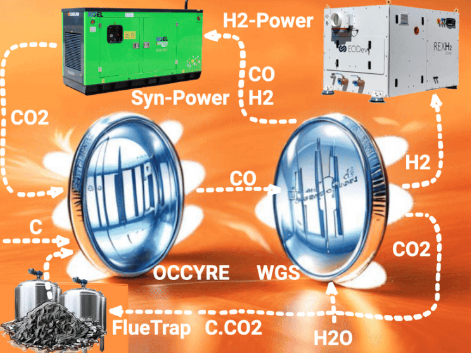Carbon Reutilization: Healing Earth in 7 Steps
Advanced Renewable
Tue , 14 May 2024 12:31 WIB

Our earth is not well, the symptoms are very clear with its 'body temperature' which continues to break new records. Hot air of 40 degrees Celsius has now become commonplace, in a number of countries it has even reached records in the 50s, and one country reached 60s! If this is not addressed immediately, we can imagine what will happen next.
So the sketch below is what we can do quickly to restore this not well earth. Because our problems are from carbon, the solution is also from carbon - in difficulty there is ease!
First, change the carbon source in the form of rubbish, waste and even coal (1) into carbon that is close to pure through the carbonization process. Then, after being activated and functionalized into Activated and Functionalized Carbon (AFC), use this AFC to capture CO2 emissions which are currently the cause of the problem on the earth (2).
The third step is to react C and CO2 to become CO (3). Once it becomes CO, we can use it to produce whatever regenerative energy we need, but this time we use CO to produce H2 (4). What is the importance of this H2? If it is used as energy, it is very clean energy, it can also be the main element along with N2 for the green revolution, namely the production of ammonia.
N2 is obtained from air (5) which contains a lot of N2 (around 78% of air is nitrogen). Because the majority of plants cannot fix N2 directly from the air, it must first be processed into NH3. When H2 from step 4 and N2 from step 5 are reacted in a process called Haber-Bosch, ammonia (NH3) is produced which plants really need to produce chlorophyll (6).
This plant chlorophyll is what we need to absorb the remaining CO2 in the earth's atmosphere, and produce clean air in the form of oxygen which is also needed for breathing for all citizens of the Animal Kingdom on earth - including humans.
However, one more step is still needed so that the hard-earned NH3 can be truly effective in growing plants on the entire surface of the earth which is currently still arid, including in desert countries. We need to 'store' NH3 in such a way that it is strong enough or safe to store and not volatile or eroded by water, but weak enough to be easily absorbed by plants.
For this we can store NH3 as a Slow Release Fertilizer (SRF) in the form of ammonium carbonate - (NH4)2CO3, for this NH3 is simply reacted with CO2 which comes from waste emissions in step 4 and water (7). So with these 7 steps there will no longer be excess CO2 wandering around in the earth's atmosphere, nor will the earth's surface be left to become a desert - in a desertification process, all types of plants can easily grow in abundance through the availability of the SRF mentioned above.
Pos Lainnya
Perspektif Baru, Energi Baru
May 14, 2024
Visual Quality of Your Own Gas
May 14, 2024
Two Sides of the Same Coin of CO2
May 14, 2024
SDG No 7 Enabler
May 14, 2024
Kategori
Environment






Silakan mendaftar terlebih dahulu!
Untuk memposting komentar baru. Anda harus login terlebih dahulu. Masuk
Komentar
Tidak ada komentar